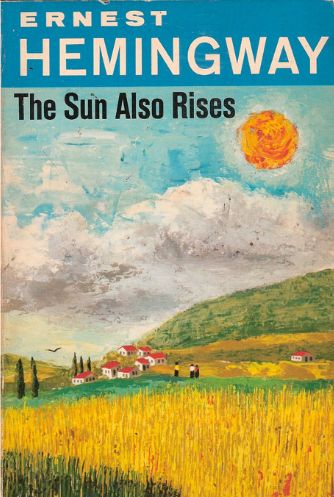
Cover Painting By James and Ruth McCrea
Hemingway was a favourite of mine, back when I used to carry books with me wherever I went. I don't do that as much now, but I do keep up with my fiction reading. I’m often re-reading older classics. Current fiction writers leave me unsatisfied. I can see their talent (of the talented ones, that is), but their stories are imbued with their personalities, as though they cannot shake off their egos as they write. Also, their stories have macabre, strange, or nihilistic endings, and I come away bewildered or depressed.
I've read four of Hemingway’s books: The Sun Also Rises, A Farewell to Arms, For Whom the Bell Tolls and The Old Man and the Sea, and many of his short stories. I'm not a literary critic, so I don't really know how to start analyzing Hemingway's writing - it's already been done ad infinitum anyway by experts and laymen alike. The first three are told in first person, and are accounts of unrequited love in many ways. The protagonists are too sophisticated and polished to pass off as Hemingway, but who knows, they could be his alter-ego. He brings them to life so clearly. They enter into all kinds of debacles, yet they come out surprisingly pure and unblemished despite their weaknesses and failures. Even The Old Man and the Sea reads like an autobiographical story of Hemingway himself - he wrote it twenty-five years afterThe Sun Also Rises, and was fifty-two years old, an age when the end of life gets closer.
I'm re-reading The Sun Also Rises. What surprises me this time around are the long, unending sentences that Hemingway uses at times, producing almost a trance-like meditative quality. This goes against the hard simplicity of his prose that many analysts have described. His description of places, whether it is a café in Paris, or the Spanish (and Italian) countryside, resonates in my mind – always has – and is an urge to visit these vivid locales.
Here is a quote from The Sun Also Rises, describing a walk in the beautiful northern Spanish countryside:
We packed the lunch and two bottles of wine in the rucksack, and Bill put it on. I carried the rod-case and the landing-nets slung over my back. We started up the road and then went across a meadow and found a path that crossed the fields and went toward the woods on the slope of the first hill. We walked across the fields on the sandy path. The fields were rolling and grassy and the grass was short from the sheep grazing. The cattle were up in the hills. We heard their bells in the woods.
The path crossed a stream on a foot-log. The log was surfaced off, and there was a sapling bent across for a rail. In the flat pool beside the stream tadpoles spotted the sand. We went up a steep bank and across the rolling fields. Looking back we saw Burguete, white houses and red roofs, and the white road with a truck going along it and the dust rising.
Beyond the fields we crossed another faster-flowing stream. A sandy road led down to the ford and beyond into the woods. The path crossed the stream on another foot-log below the ford, and joined the road, and we went into the woods.
It was a beech wood and the trees were very old. Their roots bulked above the ground and the branches were twisted. We walked on the road between the thick trunks of the old beeches and the sunlight came through the leaves in light patches on the grass. The trees were big, and the foliage was thick but it was not gloomy. There was no undergrowth, only the smooth grass, very green and fresh, and the big gray trees well spaced as though it were a park.
"This is country," Bill said.
The road went up a hill and we got into thick woods, and the road kept on climbing. Sometimes it dipped down but rose again steeply. All the time we heard the cattle in the woods. Finally, the road came out on the top of the hills. We were on the top of the height of land that was the highest part of the range of wooded hills we had seen from Burguete. There were wild strawberries growing on the sunny side of the ridge in a little clearing in the trees.
Ahead the road came out of the forest and went along the shoulder of the ridge of hills. The hills ahead were not wooded, and there were great fields of yellow gorse. Way off we saw the steep bluffs, dark with trees and jutting with gray stone, that marked the course of the Irati River.
"We have to follow this road along the ridge, cross these hills, go through the woods on the far hills, and come down to the Irati valley," I pointed out to Bill.
